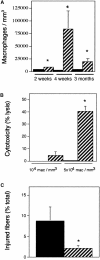A nitric oxide synthase transgene ameliorates muscular dystrophy in mdx mice
- PMID: 11581289
- PMCID: PMC2150800
- DOI: 10.1083/jcb.200105110
A nitric oxide synthase transgene ameliorates muscular dystrophy in mdx mice
Abstract
Dystrophin-deficient muscles experience large reductions in expression of nitric oxide synthase (NOS), which suggests that NO deficiency may influence the dystrophic pathology. Because NO can function as an antiinflammatory and cytoprotective molecule, we propose that the loss of NOS from dystrophic muscle exacerbates muscle inflammation and fiber damage by inflammatory cells. Analysis of transgenic mdx mice that were null mutants for dystrophin, but expressed normal levels of NO in muscle, showed that the normalization of NO production caused large reductions in macrophage concentrations in the mdx muscle. Expression of the NOS transgene in mdx muscle also prevented the majority of muscle membrane injury that is detectable in vivo, and resulted in large decreases in serum creatine kinase concentrations. Furthermore, our data show that mdx muscle macrophages are cytolytic at concentrations that occur in dystrophic, NOS-deficient muscle, but are not cytolytic at concentrations that occur in dystrophic mice that express the NOS transgene in muscle. Finally, our data show that antibody depletions of macrophages from mdx mice cause significant reductions in muscle membrane injury. Together, these findings indicate that macrophages promote injury of dystrophin-deficient muscle, and the loss of normal levels of NO production by dystrophic muscle exacerbates inflammation and membrane injury in muscular dystrophy.
Figures








References
-
- Abu-Soud, H.M., and S.L. Hazen. 2000. Nitric oxide modulates the catalytic activity of myeloperoxidase. J. Biol. Chem. 275:5425–5430. - PubMed
-
- Albina, J.E., S. Cui, R.B. Mateo, and J.S. Reichner. 1993. Nitric oxide-mediated apoptosis in murine peritoneal macrophages. J. Immunol. 150:5080–5085. - PubMed
-
- Amalfitano, A., and J.S. Chamberlain. 1996. The mdx-amplification-resistant mutation system assay, a simple and rapid polymerase chain reaction-based detection of the allele. Muscle Nerve. 19:1549–1553. - PubMed
-
- Arahata, K., and A.G. Engel. 1984. Monoclonal antibody analysis of mononuclear cells in myopathies. I: Quantitation of subsets according to diagnosis and sites of accumulation and demonstration and counts of muscle fibers invaded by T cells. Ann. Neurol. 16:193–208. - PubMed
Publication types
MeSH terms
Substances
LinkOut - more resources
Full Text Sources
Other Literature Sources
Molecular Biology Databases

